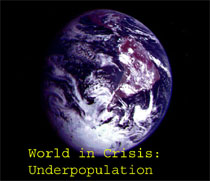A prominent pro-life group in England says Andrew Mitchell, secretary of state for international development, “is stuck in the era of anti-birth dinosaurs” because he is missing the boat on underpopulation concerns plaguing the world.
The Society for the Protection of Unborn Children (SPUC) is responding to just-published parliamentary answers in which Mr Mitchell said that the UK government backs so-called “family planning” to “help reduce unwanted fertility and reduce population growth.”
 Paul Tully, SPUC’s general secretary, commented: “Andrew Mitchell blames environmental degradation on poor people who have more children than he thinks they should. This kind of thinking should be consigned to the history books, along with the attitude that the poor are to blame for their own existence. The reality is that development can only happen with sufficient concentration of human resources – of people – to enable infrastructure to be built and maintained. Waste recycling, flood defenses and sewage treatment are examples of systems that are beyond the means of poor, sparsely-populated areas.”
Paul Tully, SPUC’s general secretary, commented: “Andrew Mitchell blames environmental degradation on poor people who have more children than he thinks they should. This kind of thinking should be consigned to the history books, along with the attitude that the poor are to blame for their own existence. The reality is that development can only happen with sufficient concentration of human resources – of people – to enable infrastructure to be built and maintained. Waste recycling, flood defenses and sewage treatment are examples of systems that are beyond the means of poor, sparsely-populated areas.”
Tully continued, “Mr Mitchell claims that current levels of growth are unsustainable, but that is not the case. Populations in many western countries would already be shrinking but for immigration from poorer countries. In the developing world, an increasing number of countries have birthrates below replacement level, and all the factors affecting fertility are moving in an anti-natal direction. Factors like age at marriage, age at first child-bearing, educational levels, etc., are all tending to reduce fertility rates. Birthrates are falling everywhere, and falling faster than anyone anticipated in the 1970s.”
“Mr Mitchell needs to wake up to the fact that the era of the so-called population bomb is history. The danger now is that developing countries will go into premature population decline and stunt their educational, economic and cultural development,” he said.
Tully concluded: “Mr Mitchell cites the 1994 International Conference on Population and Development as grounds for promoting family planning, but ICPD said that abortion should never be promoted as a means for family planning. In its May 2011 spending review, DfID announced that it will spend nearly half a billion pounds on projects that include reproductive health which covers both abortion and contraception. DfID won’t say how much of this goes on abortion, but we know it funds lobbying, infrastructure and services for abortion. Tax payers have a right to know how DfID is spending their money, and how many babies are dying as a result.”
In May, the United Nations Populations Fund (UNFPA) continued to call for more population control.
The Population Division of the UN Department of Economic and Social Affairs released a projection that the world population will reach 7 billion on October 31 of this year. The UNFPA used this as an opportunity to call[1] for more family planning services in order to decrease fertility rates worldwide.
But Bill Saunders of the U.S.-based Americans United for Life, said the call was wrong.
“The call for population control is a false alarm. Birthrates are already dropping worldwide. Many countries have fertility rates that are well below replacement rate,” Saunders said. “In order to maintain a steady population that does not increase and does not decrease, a country must have a fertility rate of 2.1. This is the replacement rate. If each woman has an average of 2.1 children, she will replace herself and a man, and allow for the occasion in which some children will not make it to maturity in order to replace themselves. A fertility rate below 2.1 children per woman means that a country will not replace itself.”
“Russia is a perfect example of this. Today Russia’s population is disappearing. From 1985 to 1990, Russia had a fertility rate that just met replacement, 2.12 children per woman. Russia’s fertility rate dropped drastically from 2005 to 2010, to 1.44 children per woman.[2] Similarly, Russia’s total population has decreased from 148,244,000 people in 1990, to 142,958,000 in 2010.[3] That is a decrease of 5,268,000 people in 20 years. A significant factor is Russia’s declining birthrate is abortion. An unofficial estimate signifies that there are 4 million abortions a year in Russia as compared to only 1.7 million live births,” he explained.







